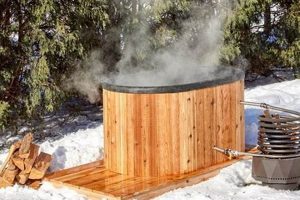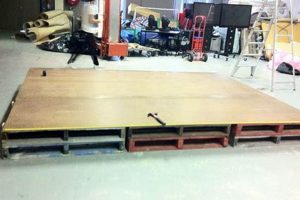A self-constructed wooden surface designed for performing tasks is a fundamental component in workshops and garages. This structure provides a stable platform for activities such as woodworking, metalworking, and general repairs. Its construction typically involves assembling a frame, legs, and a work surface from lumber.
The advantages of creating a customized work area include tailoring dimensions and features to specific needs and available space. Historically, these essential pieces of equipment have been central to craftsmanship, evolving in design and materials to meet the demands of various trades. A well-built, personally designed station enhances efficiency and supports precision in project execution.
The subsequent sections will address key considerations for planning, material selection, construction techniques, and safety protocols associated with erecting a robust and functional surface. These guidelines will help ensure the creation of a lasting and adaptable workspace.
Essential Construction Guidance
Optimizing the outcome of a self-assembled wooden workstation necessitates careful consideration of several key factors during its design and construction. The following recommendations offer practical guidance for building a durable and functional structure.
Tip 1: Plan Dimensions Strategically: Prior to commencing construction, determine the optimal dimensions based on available space and intended use. Larger surfaces accommodate bigger projects, while compact designs suit confined areas. Consider the height of the user to ensure ergonomic comfort.
Tip 2: Select Durable Materials: Opt for hardwoods such as maple or oak for the work surface to withstand heavy use and resist damage. Softwoods like pine can be used for the frame, provided they are adequately reinforced at stress points.
Tip 3: Ensure a Stable Frame: The frame provides the structural foundation. Employ mortise and tenon joints or robust screw connections for maximum stability. Cross braces between the legs significantly reduce wobble and enhance overall rigidity.
Tip 4: Flatten the Work Surface: A perfectly flat work surface is crucial for accurate project execution. Use a jointer and planer to prepare the lumber, and employ shims if necessary to level the assembled surface.
Tip 5: Integrate Storage Solutions: Incorporate drawers, shelves, or pegboards to organize tools and materials. Strategic placement of storage components maximizes efficiency and minimizes clutter within the workspace.
Tip 6: Apply a Protective Finish: Seal the wood with a durable finish, such as polyurethane or epoxy resin, to protect it from moisture, chemicals, and abrasion. Multiple coats ensure long-lasting protection.
Tip 7: Consider Mobility Options: Depending on workspace constraints, installing heavy-duty casters allows for easy relocation. Ensure the casters are lockable to maintain stability during use.
These tips enhance the longevity and usability of a custom-built workstation. Implementing these techniques results in a more efficient and enjoyable working environment.
The concluding section will summarize the key aspects of building a practical and long-lasting wooden workstation.
1. Design Dimensions
The success of a self-constructed wooden workstation is intrinsically linked to its dimensions. Ill-considered measurements result in a structure that is either impractical within the allocated space or fails to adequately support the intended tasks. Careful planning of length, width, and height is, therefore, not merely a preliminary step but a foundational determinant of the workbench’s overall utility. Insufficient length restricts the ability to process larger materials, while inadequate width limits maneuverability around the workpiece. Height impacts ergonomics; a station that is too low causes back strain, while one that is too high hinders precision.
A common error involves neglecting the scale of typical projects. For example, a model builder requires a comparatively small surface, whereas a furniture maker benefits from a larger footprint. Another frequent oversight is the underestimation of storage requirements. Integrating storage, such as drawers or shelves, into the design necessitates adjusting dimensions accordingly. Failure to accurately account for these elements leads to a workspace that is either too cramped or inefficiently utilized. Furthermore, considerations of accessibility are vital. Clearance around the perimeter and proximity to power outlets or other equipment also influences optimum dimensions.
In conclusion, design dimensions are not arbitrary but are a critical factor governing the functionality and practicality. A thoughtful, deliberate approach to measuring and configuring the workspace ensures that the resulting structure meets the specific demands of the intended applications. Disregarding these factors results in a compromise of utility and efficiency, diminishing the overall value of the self-built workstation.
2. Material Selection
The selection of materials constitutes a critical juncture in the successful fabrication of a self-constructed wooden workstation. Material properties directly influence the structure’s durability, stability, and suitability for the intended tasks. Improper material choices compromise the workbench’s structural integrity and shorten its lifespan.
- Hardwood vs. Softwood
Hardwoods, such as maple, oak, and beech, exhibit greater density and resistance to wear than softwoods like pine, fir, and cedar. Work surfaces constructed from hardwoods withstand the repeated impact and abrasion associated with woodworking, metalworking, and other demanding activities. Softwoods, while less expensive and easier to work with, are prone to denting and scratching. Therefore, hardwoods are typically reserved for the work surface and areas subject to heavy use, while softwoods serve for framing components or less critical elements.
- Lumber Grade and Quality
Lumber is graded based on the presence of knots, imperfections, and overall quality. Higher grades, such as FAS (Firsts and Seconds) or Select, are relatively free of defects and provide superior structural integrity. Lower grades, such as Common, contain more knots and blemishes, which may weaken the wood and complicate joinery. While lower grades are more economical, selecting lumber of appropriate grade is essential for ensuring the workbench’s stability and longevity. Clear lumber is more expensive but preferred for work surfaces.
- Fasteners and Adhesives
Fasteners and adhesives play a vital role in securing the various components. Screws offer superior holding power compared to nails, particularly when joining hardwoods. Wood glue, specifically designed for woodworking, provides a strong and durable bond that surpasses that of general-purpose adhesives. The selection of appropriate fasteners and adhesives, coupled with proper application techniques, reinforces the structural integrity of the workbench and minimizes the risk of joint failure under load.
- Protective Coatings
Protective coatings, such as polyurethane, varnish, and epoxy resin, shield the wood from moisture, chemicals, and abrasion. These coatings penetrate the wood pores, forming a barrier against environmental factors that can cause warping, cracking, and staining. Applying multiple coats of a durable finish extends the lifespan of the workbench and maintains its aesthetic appearance over time. Linseed oil is also sometimes used, requiring several coats and an extended drying time.
Therefore, mindful material selection is paramount to constructing a wooden workstation that not only fulfills its intended purpose but also withstands the rigors of regular use. Careful consideration of the wood species, lumber grade, fasteners, adhesives, and protective coatings optimizes the workbench’s performance and ensures its longevity. Failure to adequately account for these material properties compromises the structures integrity and reduces its overall value.
3. Frame Stability
Frame stability represents a foundational element in the construction of a self-assembled wooden workstation. The integrity of the frame directly influences the usability, safety, and longevity of the entire structure. A structurally deficient frame compromises the work surface’s ability to support loads, increases the risk of collapse, and hinders precise execution of tasks.
- Joint Integrity
The method of joining frame components dictates the overall stability. Traditional joinery techniques, such as mortise and tenon or dovetail joints, provide exceptional strength and resistance to racking forces. Modern methods, including screws and bolts, offer a simpler alternative, provided they are appropriately sized and reinforced with wood glue. Weak or poorly executed joints introduce play into the structure, leading to instability and potential failure under load.
- Material Dimensions
The dimensions of the lumber used for the frame directly impact its load-bearing capacity. Insufficiently sized lumber deflects under load, causing the work surface to sag and compromising the workbench’s utility. Thicker lumber, while more expensive, provides greater rigidity and resistance to bending. Selecting appropriate lumber dimensions based on the intended load and span is crucial for ensuring frame stability.
- Cross Bracing
Cross bracing, implemented either diagonally or horizontally, significantly enhances a frame’s resistance to racking forces. These braces distribute loads across the frame, preventing deformation and maintaining structural integrity. Without adequate cross bracing, the frame is susceptible to swaying or collapsing under lateral forces. Strategically positioned cross braces are essential for maximizing frame stability, particularly in larger or taller workbenches.
- Leveling and Support
Even on a perfectly level floor, slight variations in leg length or frame construction can induce instability. Adjustable leveling feet compensate for these discrepancies, ensuring that all legs bear weight evenly. Additional support structures, such as a lower shelf or a cabinet base, further enhance frame stability by distributing the load and minimizing wobble.
In conclusion, frame stability is not merely a design consideration but a fundamental requirement for any functional wooden workstation. The integration of robust joinery, appropriately sized materials, effective cross bracing, and precise leveling techniques is paramount to creating a safe, reliable, and enduring workspace.
4. Surface Flatness
The level of planarity achieved in a self-constructed wooden workstation is directly proportional to the precision attainable in subsequent projects. A surface exhibiting inconsistencies, such as humps, dips, or twists, introduces errors into cutting, assembly, and finishing operations. This deviation from true flatness creates a ripple effect, compounding inaccuracies across multiple stages of a project. For instance, attempting to assemble a cabinet on an uneven surface results in misaligned joints and a structurally unsound final product.
Achieving and maintaining a level work surface necessitates careful lumber selection and preparation. The use of warped or cupped boards introduces inherent irregularities that are difficult to rectify post-assembly. Furthermore, environmental factors such as humidity fluctuations can induce warping in even initially flat surfaces. Therefore, the conscientious application of flattening techniques, such as planing, jointing, and the strategic use of shims, is crucial. Consider the construction of a guitar neck; even minute deviations from flatness along the fretboard render the instrument unplayable, illustrating the criticality of this parameter in woodworking.
In summary, surface flatness is not merely an aesthetic concern, but a functional imperative for a self-made wooden workstation. Failure to prioritize and achieve a consistently level surface compromises the accuracy and quality of all subsequent tasks performed on that workstation. The integration of proper lumber selection, flattening techniques, and ongoing monitoring and adjustment ensures that the workbench serves as a reliable platform for precise and accurate work.
5. Storage Integration
The inclusion of integrated storage solutions within a self-constructed wooden workstation transforms the structure from a mere work surface into a comprehensive organizational system. This feature directly impacts workflow efficiency and workspace management, optimizing accessibility to tools and materials while minimizing clutter.
- Drawer Systems
Drawer systems provide enclosed storage for hand tools, measuring devices, and frequently used hardware. Dimensions of drawers should align with the size and quantity of anticipated contents. For example, shallow drawers facilitate quick access to small items such as screws and nails, while deeper drawers accommodate larger tools like planes and saws. Integration of drawer slides enables smooth operation and maximizes usable space.
- Shelving Units
Shelving units, either open or enclosed, offer versatile storage for larger items such as power tools, project materials, and reference books. Adjustable shelves allow for customization based on item height and volume. Strategic placement of shelving units, such as beneath the workbench or on adjacent walls, maximizes floor space utilization.
- Pegboard Panels
Pegboard panels provide easily accessible and customizable storage for frequently used tools. Hooks and hangers of various sizes accommodate a diverse range of implements, from screwdrivers and pliers to saws and chisels. Pegboard systems promote organization by visually displaying tool locations and minimizing search time.
- Cabinet Bases
Incorporating a cabinet base into the workstation frame provides enclosed storage for larger or more valuable items, such as power tools, finishing supplies, and delicate instruments. Lockable cabinets offer secure storage for hazardous materials or tools requiring controlled access. Cabinet design should complement overall workstation dimensions and aesthetic considerations.
Effective storage integration transcends mere space allocation; it represents a strategic approach to optimizing workspace functionality. A well-designed storage system enhances workflow efficiency, minimizes clutter, and promotes a safe and organized working environment, ultimately improving the quality and efficiency of projects undertaken on the custom-built wooden workstation.
6. Protective Finishing
Protective finishing is an indispensable element in the realm of self-constructed wooden workstations. The application of a suitable finish is a direct determinant of the structure’s longevity and resilience against various environmental and operational stressors. An unfinished surface is inherently vulnerable to moisture absorption, leading to warping, swelling, and eventual structural degradation. Furthermore, the absence of a protective layer renders the wood susceptible to staining from spills, scratches from tools, and chemical damage from solvents or adhesives commonly used in workshop environments. Therefore, the selection and application of an appropriate finish are paramount to safeguarding the investment of time, effort, and materials inherent in the construction of a personalized workstation.
Numerous finishing options exist, each offering varying degrees of protection and aesthetic characteristics. Polyurethane coatings provide a durable, water-resistant barrier ideal for heavy-use surfaces. Oil-based finishes, such as linseed or tung oil, penetrate the wood fibers, enhancing their natural color and providing some protection against moisture. Water-based finishes offer lower VOC emissions and ease of cleanup but may not provide the same level of durability as solvent-based alternatives. Epoxy resin creates an exceptionally robust and chemical-resistant surface, suitable for workstations subjected to harsh conditions. Proper surface preparation, including sanding and cleaning, is crucial for ensuring optimal adhesion and performance of the chosen finish. Multiple thin coats are generally preferable to a single thick coat, promoting even coverage and minimizing the risk of drips or runs. Example: A workbench used for automotive repairs necessitates a chemical-resistant epoxy finish to withstand exposure to oils and solvents. Conversely, a workbench used primarily for light woodworking may be adequately protected by a few coats of polyurethane.
In summary, protective finishing constitutes a critical and non-negotiable step in the fabrication of a enduring wooden workstation. The selection of an appropriate finish should be predicated on the intended use of the workbench and the environmental conditions to which it will be exposed. Inadequate or absent finishing compromises the structural integrity and aesthetic appeal of the piece, significantly diminishing its long-term value and utility.
7. Mobility Options
The integration of mobility options into a self-constructed wooden workstation design addresses the dynamic spatial requirements of various work environments. Incorporating mechanisms for relocation enhances adaptability, facilitating reorganization and efficient utilization of available floor space. While fixed workstations offer stability, mobile alternatives present enhanced flexibility, particularly in confined areas or multi-purpose environments.
- Caster Selection
The selection of appropriate casters is paramount for realizing effective mobility. Factors governing caster choice include load-bearing capacity, wheel diameter, and material composition. Heavy-duty casters with locking mechanisms are essential for supporting substantial weight and ensuring stability during use. Larger wheel diameters facilitate easier movement over uneven surfaces. Material composition, such as polyurethane or rubber, influences rolling resistance and floor protection. Improper caster selection compromises mobility and poses safety risks.
- Frame Reinforcement
The introduction of mobility, particularly with heavy loads, imposes additional stress on the workbench frame. Reinforcement of the frame structure is therefore critical to prevent deformation or failure. Welding steel supports, incorporating thicker lumber, or implementing additional cross-bracing enhances the frame’s capacity to withstand the dynamic forces associated with movement. Neglecting frame reinforcement compromises the workbench’s structural integrity and reduces its lifespan.
- Braking Mechanisms
Reliable braking mechanisms are essential for ensuring stability during operation. Locking casters prevent unintended movement, enhancing safety and precision. The type of braking mechanism, whether lever-operated or foot-activated, should be readily accessible and easily engaged. Failure to adequately secure the workstation during use poses safety hazards and hinders accurate work.
- Handle Integration
Incorporating handles or grips facilitates controlled maneuvering of the mobile workstation. Ergonomically designed handles reduce strain and improve maneuverability, especially when navigating confined spaces. The placement of handles should optimize leverage and minimize the effort required to move the workstation. Absence of appropriate handles compromises user control and increases the risk of injury.
The implementation of mobility options within a self-constructed wooden workstation necessitates a holistic design approach that considers caster selection, frame reinforcement, braking mechanisms, and handle integration. These components, when properly integrated, transform a static structure into a dynamic asset, enhancing adaptability and efficiency within the work environment.
Frequently Asked Questions About DIY Wood Workbenches
This section addresses common inquiries regarding the planning, construction, and maintenance of self-constructed wooden work surfaces. The information provided aims to clarify crucial aspects and dispel potential misconceptions.
Question 1: Is hardwood always necessary for a DIY wood workbench surface?
Hardwood, such as maple or oak, offers superior durability and resistance to wear compared to softwood alternatives. While hardwood is recommended for heavy-duty applications, a softwood surface, constructed from pine or fir, can be adequate for lighter tasks, provided it is appropriately sealed and reinforced.
Question 2: What is the ideal height for a DIY wood workbench?
The optimal height varies depending on the user’s stature and the types of tasks performed. A general guideline suggests setting the work surface at a height that allows the user to work comfortably with elbows bent at a 90-degree angle. Adjustable-height designs offer greater flexibility.
Question 3: How can a DIY wood workbench be effectively leveled?
Leveling a workbench involves addressing any discrepancies in leg height or floor unevenness. Adjustable leveling feet provide a simple solution. Shims, inserted beneath the legs, can also compensate for minor height differences. A spirit level is essential for accurate assessment and adjustment.
Question 4: Are specialized tools required to build a DIY wood workbench?
While advanced woodworking tools can expedite the construction process, a functional workbench can be assembled using basic tools such as a circular saw, drill, and measuring instruments. The complexity of the design influences the tool requirements.
Question 5: How can a DIY wood workbench be protected from moisture?
Moisture protection is crucial for preventing warping and rot. Applying a durable finish, such as polyurethane or epoxy resin, seals the wood and creates a barrier against moisture penetration. Regular reapplication of the finish is recommended.
Question 6: What is the best way to secure a DIY wood workbench frame?
Secure frame construction relies on robust joinery techniques. Mortise and tenon joints offer exceptional strength. Alternatively, screws and wood glue provide a simpler, yet effective, method of securing frame components. Adequate cross-bracing enhances stability.
In summary, understanding material properties, ergonomic considerations, and appropriate construction techniques is essential for creating a durable and functional self-built workbench. Careful planning and execution ensure a workspace tailored to specific needs.
The subsequent section will present concluding remarks summarizing the key benefits and considerations discussed throughout this article.
DIY Wood Workbench
This exposition has detailed the multifaceted considerations inherent in the creation of a self-assembled wooden work surface. From the strategic selection of materials and the implementation of robust joinery techniques to the integration of storage solutions and the application of protective finishes, each element contributes to the overall functionality and longevity of the final product. The importance of surface planarity, frame stability, and ergonomic design has been consistently emphasized.
The construction of a durable and efficient workstation represents a significant investment of time and resources. Diligent application of the principles outlined herein will yield a structure that not only meets immediate needs but also provides enduring value for years to come. Those undertaking such projects should proceed with meticulous planning and diligent execution.



![[DIY Guide] Easy DIY Wood Window Shutters You Can Build! The DIY Hub: Creative Crafts, Repairs & Life Hacks [DIY Guide] Easy DIY Wood Window Shutters You Can Build! | The DIY Hub: Creative Crafts, Repairs & Life Hacks](https://craftingdiycenter.com/wp-content/uploads/2025/07/th-3579-300x200.jpg)



